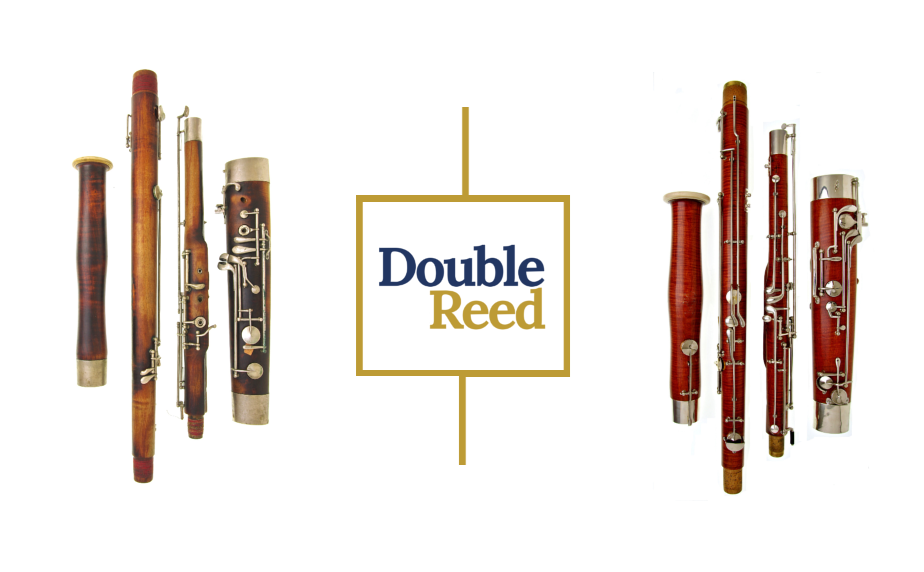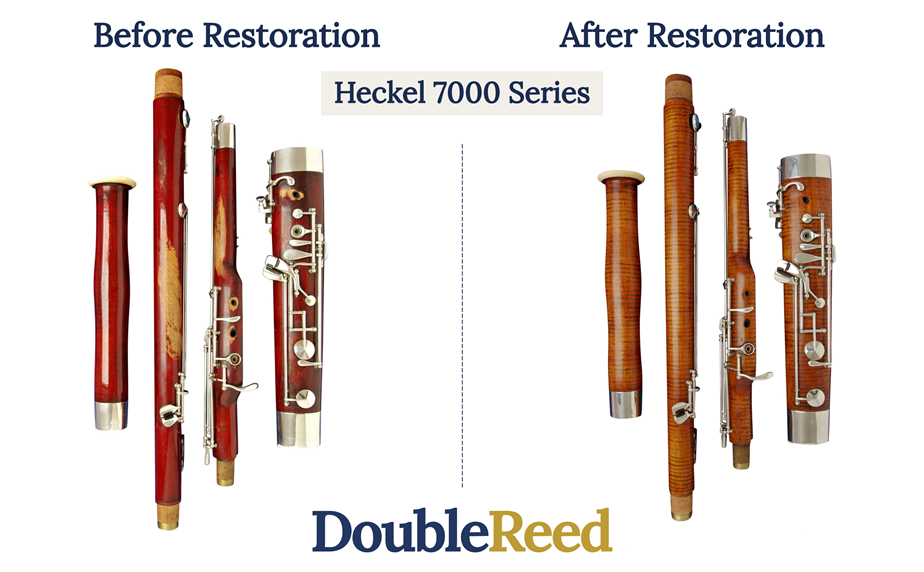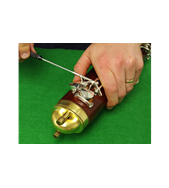The bassoon; an aesthetic debate
June 28th, 2018

A 1920s G. Mollenhauer bassoon (left) and a pre-war Kohlert bassoon being restored at the Double Reed Ltd. bassoon repair workshop
Article Author: Oliver Ludlow, In-House-Bassoon Specialist and Director at Double Reed Ltd.
In the Double Reed Ltd. bassoon workshop we have had two bassoons which have thrown up some interesting questions and considerable debate – they are both pre-war instruments (a 7000 series Heckel (1936) and a 1920s G. Mollenhauer), and they are both undergoing acoustic and mechanical restoration by our repair technician. The debate surrounding these instruments is one of aesthetics.
The Mollenhauer will be fully restored acoustically and mechanically to play and perform as it would have done when it was brand new, but we have decided to leave the appearance of the bassoon intact so as to preserve its natural ‘patination’.
The Heckel has been restored both acoustically, mechanically and aesthetically back to as close to its original ‘off-the-peg’ state as possible – as well as playing and performing as it would have done when brand new, it now also looks very close to how it would have done in 1936.
Mechanical and acoustic restoration
Both of these instruments look and sound beautiful in their own right, and restoring the mechanical and acoustic functionality of the bassoons coming into our workshop is our prime aim. The goal of these aspects of restoration is to return each instrument to its original playing condition, so that they are once again textbook examples of bassoons of their period and maker – all easy to play with good intonation, and sound superb.
The aesthetic restoration debate
Once the mechanical and acoustic essentials of the restoration are completed, however, our attention turns to the aesthetic elements of the instrument.
This is where the debate fires up – to what level should one restore a bassoon’s appearance? Should it leave our workshop looking as it did the day it was made? Or do we have a duty to the authenticity of the instrument’s history.
In other words, should we sympathetically restore only where necessary - with the aim of preserving the record of it as a loved and used instrument - rather than erasing all trace of its playing-life?
In our workshop, the verdict comes down, in most cases, in favour of the latter approach - authenticity is king.
This approach to authentic and sympathetic renovation goes back to architect William Morris in the nineteenth century, when the vogue was for unsympathetic restoration and renewal of medieval buildings, which wiped out traces of their evolution and history as lived-in structures. William Morris propounded the view that all restoration should be minimal and should clearly preserve the record of the life of the building, and he started the Society for the Protection of Ancient Buildings (SPAB) to further this view. SPAB still exists, and this view forms the template for the restoration of old buildings down to the modern day, including informing the approach taken to listed buildings and listed building consent.
Our ethos is to carefully restore our bassoons so that their underlying narrative is still told, whilst endeavouring to stay true to the character of the instrument, and to honour the skills of the masters who crafted them all those years ago.
Why follow William Morris?
Have you ever seen an object that looks timeworn, but holds a striking character? A Victorian fireplace, an old stone floor, a 19th century violin? The passage of time has left its imprint on these items, yet they have retained their original quality, and gained a whole lot more – an historic charm and beauty.
In the antiques industry this well-used look is called ‘patina’ and can be found in our 1920s G. Mollenhauer – indeed, pre-war Heckels, Kohlerts, and Mollenhauers are scattered with highly sought-after examples. The patination that used bassoons acquire is the very record of its history as a treasured instrument, which forms the heart of our debate.
The William Morris approach of sympathetically preserving this look encapsulates the idea that the bassoon’s treasured timbres are matched and enriched by the patination gained in age - that a well-chosen second hand bassoon gains an aesthetic maturity over time which cannot be authentically reproduced in a new bassoon.
Take a look at the pre-war Mollenhauer in question for example:

Aside from the metal work which will need to be re-silvered, the gentle wear patterns along this bassoon’s wooden joints show a bassoon steeped in history, held and played across two vastly different pre- and post-war eras. The original colour has worn off where the bassoon has been handled, especially around the finger holes, the butt joint where the bassoon rests against the leg, and the long joint where the weight of the instrument rests on the left hand, not to mention the countless times it has been gripped to assemble and disassemble it for playing.
In response to the argument that bassoons should be scrubbed clean - their patination erased - we suggest that this is part of the history of fine quality instruments, many of which were cherished and played long before we had them, and like the buildings William Morris sought to protect, many of them will still be in use long after we are gone.
What if the bassoon’s patination is beyond preserving?
The flip side of this debate, however, rests on the idea that rather than preserving a bassoon’s history, we should return it to its former self – a display-case example of an instrument that is un-played and un-altered. This idea is respectable, but conflicts with our ethos of authenticity - used bassoons have been held, cherished, played - to erase this is to erase their character.
The consensus in our workshop is that we will recommend a complete re-varnish of instruments in only two circumstances:
- when the bassoon has been poorly and unsympathetically re-varnished in the past (which happens surprisingly often); or
- when the original varnish is in such poor condition that the wood is no longer protected and sealed against leaks or damage from dirt and water, thus affecting the long-term durability of the instrument and therefore its value.
Take a look at this 1936 Heckel 7000 Series bassoon we restored, for example:

This instrument had clear signs of mistreatment when we received it, and a previous botched varnish job had been done using thick red acrylic varnish. This varnish tends to age poorly, usually chipping off instead of wearing evenly like the original coating would have done.
It was clear that this instrument’s patination had been spoiled and its features covered over – and so with the authenticity of the bassoon in mind we decided to undertake a complete restoration. During this process we carefully removed the outer layers of varnish that had been added during its lifetime, and underneath we found the faint outlines of the beautiful original tiger stripes shown in the picture. In cases such as this, we will carefully preserve the original wood markings, or if they are too faint, as in this instance, we will meticulously trace over the original markings to bring them out as they once would have been.
Another revelation in this instance, as with many other instruments like it, occurred when removing the acrylic varnish – the original Heckel stamps were revealed, having been concealed for many decades, preserved in great condition. When we find hidden stamps like this, we are able to re-gild them to look as they first would have done.
We then colour-matched the original varnish using colour traces which were left, and restored the instrument in the original colour, with the same type of non-acrylic varnish that Heckel used when the instrument was made.
We always aim to minimise sanding, which preserves the surface layer of wood. Many other restorers choose the quicker option of sanding the whole instrument - often including the original maker’s stamps - to get a smooth finish. Instead, we use steaming methods to draw out old dents and dings so that excessive sanding is not necessary.
In undertaking this restoration project, we were able to honour the authenticity of the original bassoon and its maker, and although William Morris’ ideal of minimal restoration was made impossible by the poor state in which we received it, we were able to show far better results by applying our sympathetic restoration methods than would have been achieved by carelessly sanding the instrument down or patching it up with more acrylic varnish.
The aesthetic restoration debate – the verdict
The verdict of our aesthetic debate is that, where possible, the restoration of a bassoon should be done with William Morris’ philosophy at the fore – all aesthetic restoration work should be minimal and should clearly preserve the record of the life of the instrument, as well as its original features. This approach will emphasise the bassoon’s best features, allowing them to once again draw the eye and capture the imagination.
Where minimal restoration and preservation of the bassoon’s patination is made impossible because of its overall condition, full restoration becomes a viable option, whereby the best results can be achieved by approaching the project with sympathetic repair methods and ensuring that the instrument’s original features are respected and preserved.
To finish, a quote from William Morris himself:
"With the arrogance of youth, I determined to do no less than to transform the world with Beauty. If I have succeeded in some small way, if only in one small corner of the world, amongst the men and women I love, then I shall count myself blessed, and blessed, and blessed, and the work goes on." William Morris, The Well At The World's End: Volume I
How would you prefer your bassoon to look – like-new, or showing its history with patination?
Click here to vote in our Facebook Poll
Article Author: Oliver Ludlow, In-House-Bassoon Specialist and Director at Double Reed Ltd.



News and guides

